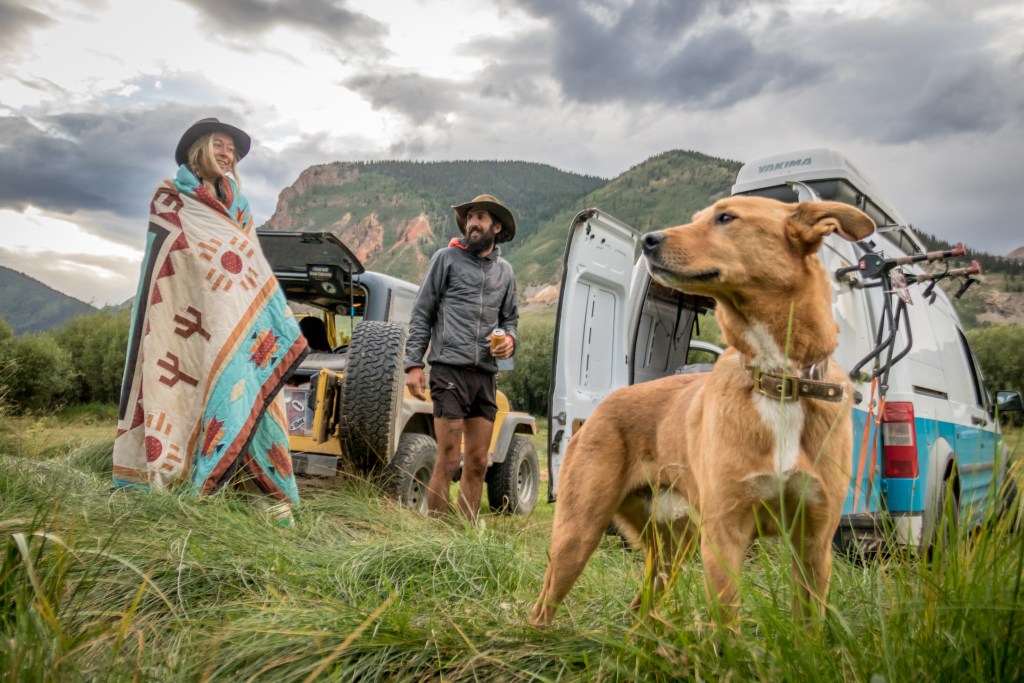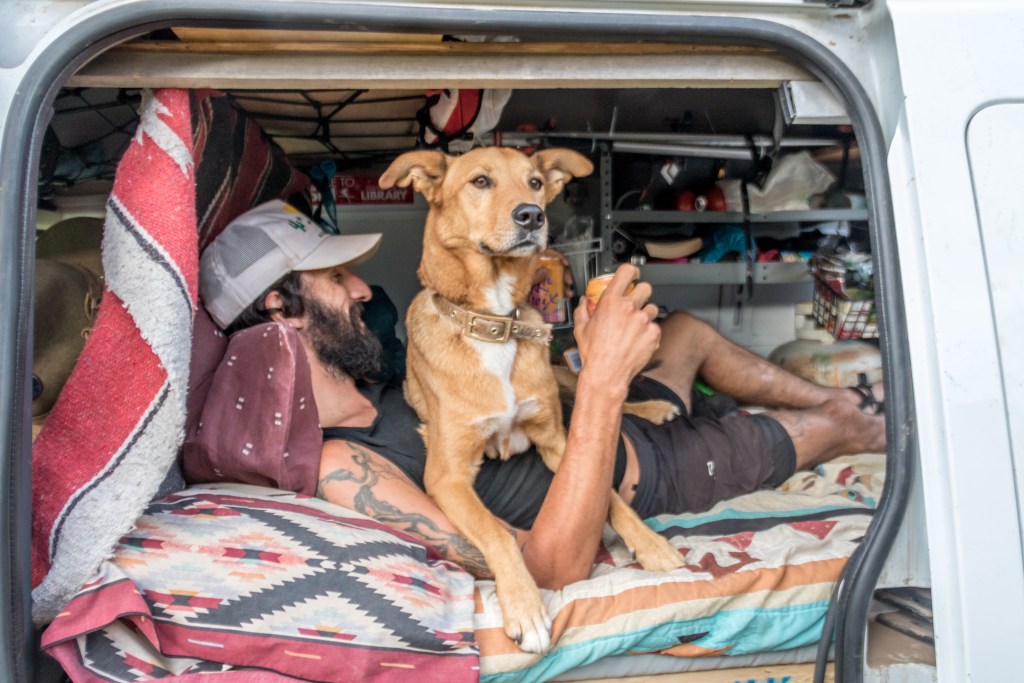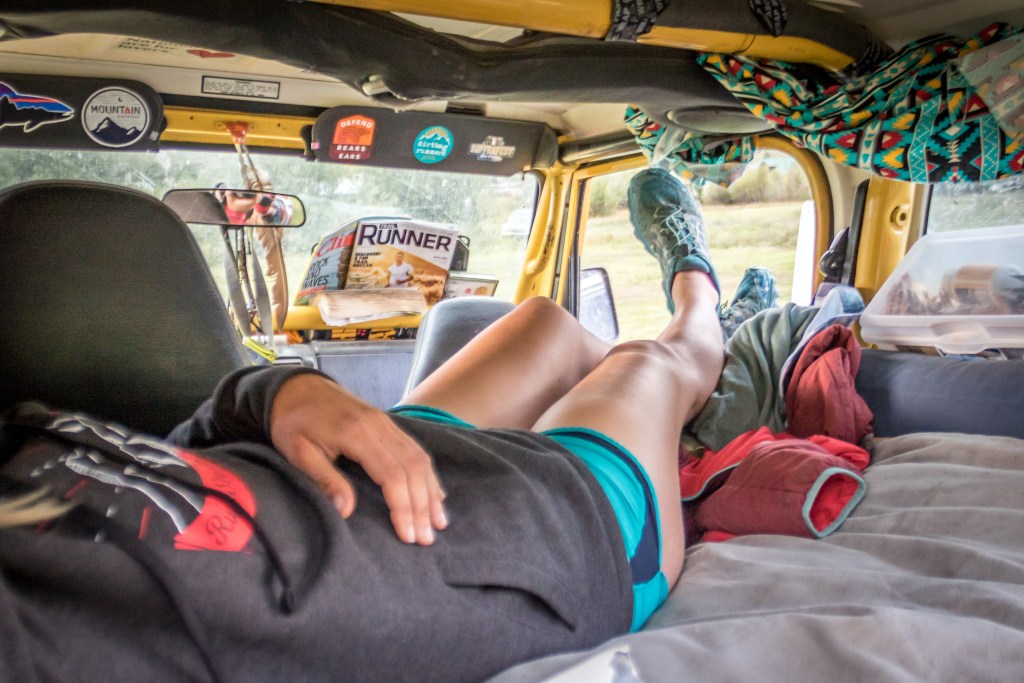A new wave of elite runners is embracing what diehard climbers have believed for decades: Home is where you park it.
“Sometimes it would be nice to take a bubble bath, then crawl into some satin sheets and watch Netflix,” says Arizona Trail Fastest Known Time (FKT) holder Michael Versteeg. He lifts another slice of pizza dripping with cheese into his mouth after a long day in the San Juan Mountains scrambling, traversing and running up and down three peaks (including two 14ers, Red Cloud and Sunshine).
Joined by Avalanche Brewery beer-tender Tyler Gault, our trio is soaked, filthy and exhausted from the long day as we savor the warmth inside Avalanche before heading home to reality: the back of our respective vehicles. We’ll park, go to bed and wake up tomorrow with a glimmer of stoke in our crusty eyes as we crawl out of our trunks, looking up at the peaks beckoning us for another big mountain run.

Morgan Sjogren and Michael Versteeg | Photo: Jubilee Paige
Living out of one’s vehicle is not new to the adventure world. For climbers, vehicle buildouts are not so much a trend as a de facto part of the sport’s hardcore culture. Versteeg, who is also an accomplished rock climber, points out that “dirtbag” was not coined as an endearing term but rather a derogatory nomenclature for the climbing vagrants living out of Yosemite’s Camp 4 in the 60s and 70s, some dumpster diving and even living on cat food to survive and devote as much time as possible to their sport.
Beyond climbing, #VanLife has exploded as a lifestyle choice (and Instagram hashtag) embraced mainly by millennials who eschew the cultural norms of 9-to-5 jobs and houses with white picket fences in favor of a simple life focused on a wealth of experiences. If Instagram posts—or even stories in The New York Times—are any indicator, a van with a kitchen sink a full-sized bed and an ocean view is the new American Dream.
They dirtbag on the weekends and live in houses and apartments during the work weeks.
Recently, trail runners have begun to adopt the trend of the road trip life with one major difference from the #VanLifers and climbing dirtbags: For many, it’s not a full-time commitment. Instead, most on-the-road trail runners are using truck and van buildouts to cut hotel costs at major races or when training in mountainous locations. In other words, they dirtbag on the weekends and live in houses and apartments during the work weeks. And they’re doing it in the West, where public lands and outdoor recreation opportunities are plentiful. Beyond climbing crags and areas like eastern Utah, parts of Colorado and the Sierras, the density of road nomads decreases radically.
I’ve been living in my 2002 Jeep Wrangler since February, but it was not until I rolled into Silverton, Colorado, the week of the Hardrock 100, that I encountered other runners living, or at least traveling and camping, out of their cars. Each July, the ultramarathon transforms Silverton into a trail running and dirtbagging mecca as participants (if they can secure one of 150 coveted entries), pacers and crew members and volunteers flock to the heart of the San Juans.
Turd’L Miller, an independent sales rep for brands like Scott Running, owns an immaculate Sprinter van that he uses for work trips and events like these where he can car camp like a king before returning to his house, wife and kids in St. George, Utah. Tory Scholz, who lives full-time in her “Vanicorn,” convinced her friends Emily and Tara to join her on a dirtbag-style road trip all the way from Oregon. And pro runner Jim Walmsley, who wasn’t competing in this year’s Hardrock, joined the high elevation village at 9,300 feet for training, simple living and the camaraderie of other trail runners before heading to Europe to race UTMB.

Michael Versteeg and his dog Herschel | Photo: Jubilee Paige
When Hardrock is said and done, the weekend warriors return to their homes, back to the office from their trail running vacation, and use the beds of their vehicles for storage more often than sleeping. But some roadies remain. For professional trail runners, living out of one’s vehicle can be a means of squeaking out a meager living while focusing on training and racing to reach the upper echelons of the sport. “I moved into my car because I could not afford to pay rent and travel as much as I wanted to,” says Nike-sponsored runner David Laney, who started living full-time in his Pontiac in 2015. (He has since upgraded to a truck that he built out with a bed.)
Versteeg originally bought his van to help support his 16-day FKT mission on the Arizona Trail and now uses it to travel to ultramarathons all over the U.S., living in it for much of the time. “At the end of the day, living this way is always a personal choice,” he says.
Moving into my Jeep helped make trips to races like the U.S. Trail Marathon and Mountain Running Championships financially feasible without a formal sponsorship, in turn allowing me to immerse myself into the highest competitive opportunities—despite being brand new to the sport. Elite runners living out of their vehicles can essentially work less than your average Joe, which means having the time and high training volume necessary to reach peak fitness. Plus, we can train at ideal locations (like high elevation and trail running meccas) while still managing to afford travel to races.
“It’s important to note that many dirtbags do this for less than a year.”
While pros like Laney, Versteeg and myself may live life on the road for much of the foreseeable future, or at least a portion of our racing careers, Crista Scott, the founder of Dirtbag Runners (a worldwide social running community that emphasizes Instagram as its hub but also offers trail running meetups throughout the year), feels that this lifestyle is not a permanent one. “I think it’s important to note that many dirtbags do this for less than a year,” she says. “In my case, it was a transition vehicle. Pun intended!”
Scott, who now lives within four walls in Los Angeles, originally hit the road in 2014 in her Honda Civic with her best friend Cat Bradley (this year’s Western States Champion), who now lives full-time in Boulder, Colorado.
“We had no idea what we were getting into, where exactly we were going or what we were going to run,” says Bradley. “Our only objective was to get to Colorado for the Silver Rush 50 and beyond that, we were just filling in the blanks. We were OK with being uncomfortable, we were OK with being dirty. In fact, we didn’t know any better. We just wanted to see as much of the West as we could.”
The duo visited and ran through many national parks, embraced a lifestyle of less-than-frequent showering and were nicknamed “The Dirtbags” by their running mentor and race director Luis Escobar.
The name stuck and now Dirtbag Runners, which has over 44,000 Instagram followers, exists to inspire runners from all walks of life with the spirit of trail running and life on the road. In fact, Dirtbag Runners’ co-founder Tyler Clemens finally drank enough of the Kool-Aid (or electrolyte drink of choice) and has hit the road full-time since summer, traveling all over the country to trails and races. “I finally got the guts to just do this and my stoke is high,” he says.

Morgan Sjogren | Photo: Jubilee Paige
Scott estimates that 80 percent of Dirtbag Runners’ members have spent a significant amount of time living on the road (with only 10 ambassadors living full-time in their vehicles) but is quick to push away any notion of this being a full-blown trend: “The dirtbag lifestyle has been around since the 60s and will continue to grow and evolve. Spending a week in the mountains or traveling to a race with your friends and camping out is fun, cheap, easy and incredibly effective at scratching that itch many of us feel.”
Suffering is the point.
I know exactly what she means. Trail running sucked me in as a means to satisfy my insatiable wanderlust, the part of me constantly seeking a new horizon around the next bend, over the next peak and dropping into the next canyon. Living full-time on the road makes these experiences more frequent but is also part of the overall quest itself. Every day presents a new set of adventures—a bumpy off-road drive to a backcountry trailhead, a new engine problem far from roadside assistance, another cold burrito choked down as a steady rain pounds the roof of my Jeep.
To us dirtbags, these are not negatives, setbacks or even obstacles, but exactly what we seek. Trail and mountain running are not easy sports. In each run or race, we elect to put ourselves on challenging paths through the most beautiful and wild spaces while pushing our bodies to their limits. In both road life and trail running, suffering is the point. It’s easy to take a pretty photo, add a hashtag and coin something a trend, but when it comes to actual dirtbagging, the reality is you either have the itch or you don’t.
